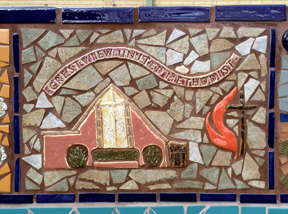Copyright 2012-2023 Susan Burneson. All rights reserved. Kindly talk with us before reproducing any website content.
In the 1960s, Mr. Peabody and Sherman, cartoon characters on The Rocky and Bullwinkle Show, traveled back in time to visit famous historical events through Mr. Peabody’s WABAC (“wayback”) machine.
 This week’s blog is an intro to our local WABAC trip, beginning next time. We include excerpts from our history exhibit and booklet, with new info, too. You might have seen the history exhibit at the Violet Crown Festival (2003-2010), Crestview United Methodist Church’s 60th anniversary celebration (2013), or Crestview Neighborhood Association’s annual ice cream social at the shopping center (2015-2016).
This week’s blog is an intro to our local WABAC trip, beginning next time. We include excerpts from our history exhibit and booklet, with new info, too. You might have seen the history exhibit at the Violet Crown Festival (2003-2010), Crestview United Methodist Church’s 60th anniversary celebration (2013), or Crestview Neighborhood Association’s annual ice cream social at the shopping center (2015-2016).
I don’t consider myself a historian. At best, I’m an amateur, in the truest sense of the word—something I do for the love of it. I became interested in history after I began to do genealogy. My interest in oral history evolved from listening to family stories as I was growing up. Our Voices of the Violet Crown project was a natural fit.
On March 29, 2009, Rob and I interviewed former Brentwood neighbor Al Kirby. He was eager to tell us what he knew about the beginnings of Crestview, before we even got started asking him any questions. Al was a boy in 1940 when he met Frank Richcreek, whose dairy farm began to be developed as part of the Crestview neighborhood seven years later. Al purchased one of the first lots in Crestview, near Justin and Yates. He told us:
After I bought the lot, I read the abstract that you used to get when you had real estate. Now that’s what you really need, because it’s got the history of how Richcreek divided the land among his children. He gave them so many acres of land, a couple of mules, that type of thing. It really was Texas history complete. If you could find somebody who had the abstract on this area and you read it, you could get some real history of actually what took place. That is the best history of the whole thing, right there. (More of Al’s great stories here.)
Abstracts of title are transcripts of all the recorded transactions affecting a particular piece of land—property sales, wills, and other legal transactions, even maps. Jean Graham loaned us a Crestview abstract a few years ago, and in 2012 neighbor Julie Chappell gave us one for a Violet Crown Heights property. Just as Al said, the abstracts have been invaluable in giving us a good overview of the people who helped develop this area. (More info about the Austin History Center‘s collection of abstracts here.)
Still, the abstracts don’t reveal what people of all colors faced as Texas and then Austin were being established in the early 1800s. Among the many challenges—Anglo Americans determined to settle an area which for many years had been home to native groups, the most dominant of them the even more determined Comanches. In the Austin area, the eastern edge of Comanche territory was the Balcones Escarpment, just west of today’s Mopac. At its peak, Comancheria covered 250,000 square miles of the Southern Plains across five states. (More info, including an excellent bibliography, in the book Empire of the Summer Moon, by S. C. Gwynne.)
Next time, we’ll continue with “WABAC Machine, Part 2,” going back a few more centuries, to about 500 B.C. . . .
